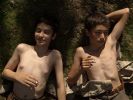Eye For Film >> Movies >> Times And Winds (2006) Film Review
In a small village in north-west Turkey nestled between arid hills and the wild sea, three pre-adolescent schoolchildren are learning sometimes harsh lessons about life and nature. Jealous of the preferential treatment given to his younger brother, Ömer (Özkan Özen) lays childish, but nonetheless dangerous, plots to kill his ailing father, the village's Imam (Bülent Emin Yarar). Yakup (Ali Bey Kayali) harbours a secret crush on his attractive young teacher (Selma Ergeç), but gradually loses all respect for his own father. Yildiz (Elit Iscan) struggles to understand why her father always takes her side while her mother always favours her little brother – and she becomes even more confused when one night she accidentally witnesses her parents having sex.
These children's painful coming of age is set against the elemental rhythms of nature and the measured hours of culture, even as the film itself is divided into five headed chapters – Night, Evening, Afternoon, Noon and Morning – designed to match the five calls to prayer that order the Muslim day. This underlies the original Turkish title of Reha Erdem's film, Bes Vakit, which translates literally as Five Times. The English-language title Times And Winds has no doubt been conconcted to avoid confusion with the title of François Ozon's 5x2 (2004) - but one suspects that Erdem was deliberately referencing Ozon, given that both directors' films feature five chapters in reverse order.

In fact, the experiences of Ömer, Yakup and Yildiz are shown unfolding in a more conventional chronological sequence than the film's formal structure might suggest, but nonetheless the seemingly anachronous organisation of the episodes points to a paradox of time that pervades the film. For although the children are driven inexorably towards adulthood, they are merely repeating the pre-determined trajectory of every previous generation, so that their personal transformations seem no less cyclical (and therefore timeless) than the passage of the seasons, the phases of the moon or the endless exchange of day and night.
Here one character is born and another dies, fathers pass on a legacy of Oedipal conflict to their sons, mothers give their daughters the same harsh treatment they themselves received as children, and despite the odd encroachment of modernity (a visiting photographer, the mosque's public-address system, the Imam's car, the teacher's new refrigerator, lessons in astronomy and science), nothing really seems to change much at all.
If at first Time And Winds, with its beatings and bestial behaviour, appears to be a reprise of the Taviani brothers' Padre Padrone (1977), it soon becomes apparent that Erdem is not interested in apportioning blame for his characters' hardships. On the contrary, far from being a barbaric patriarch who holds his son back, the Imam wishes Ömer would take education more seriously, and shows preference to his younger son precisely for his intellectual promise. And while the Imam's overt favouritism is hardly attractive, nor is Ömer's repeated rejection of his father's awkward attempts at affection and reconciliation, not to mention Ömer's own attempts at patricide. In this village, anger, resentment and jealousy come easily, and stay long – but Erdem also celebrates the strong sense of community amongst the villagers and their support network for those in need.
Times And Winds is a beautiful film, shot with a fluid lyricism by Erdem's regular cinematographer Florent Herry. Wideshot vistas of the unforgiving landscapes or of the minaret-dominated village are intercut with mobile shots that track the young principals from behind as they walk briskly through the village's labyrinth of alleyways. These latter sequences perfectly encapsulate the children's rites of passage, as they seem always to be moving forward but still never break free of circuitous paths long-established and well-trodden by their parents and grandparents before them.
Occasionally punctuating all this are disturbingly aestheticised tableaux that depict the children laid out and blanketed in twigs, stones or leaves – although it is left entirely to the viewers' imagination as to whether they are just sleeping figuratively cocooned or stone-cold dead. For this film is both as banal, and as miraculous, as the endlessly repeating metamorphoses that it portrays. Here, time does not so much heal old wounds as reopen them in new bodies – and the result is a vision that sets human progress against eternal return.
Poetic yet unsentimental, Times And Winds places human love, anguish and conflict within the larger arena of time and nature.
Reviewed on: 01 Sep 2008



















